
Servant leadership emphasizes serving employees and prioritizing their growth and well-being, fostering a collaborative and empathetic work environment. Bureaucratic leadership relies on strict rules, hierarchical structure, and formal procedures to maintain order and efficiency within organizations. Explore their distinct impacts on organizational culture and performance to determine the best leadership style for your team.
Why it is important
Understanding the difference between servant leadership and bureaucratic leadership is crucial for effective management because it impacts organizational culture and employee motivation. Servant leadership focuses on empowering and supporting employees, fostering collaboration and innovation. Bureaucratic leadership prioritizes rules, procedures, and hierarchical control, which can ensure consistency but may limit flexibility. Choosing the appropriate style enhances decision-making, productivity, and employee satisfaction.
Comparison Table
| Aspect | Servant Leadership | Bureaucratic Leadership |
|---|---|---|
| Definition | Leadership focused on serving and prioritizing team needs. | Leadership based on strict rules, hierarchy, and procedures. |
| Decision-Making | Collaborative and empathetic, involving team input. | Centralized and rule-bound, following formal protocols. |
| Focus | Employee growth, empowerment, and well-being. | Efficiency, consistency, and adherence to policies. |
| Flexibility | Adaptable to individual and team needs. | Rigid structure with limited flexibility. |
| Motivation | Intrinsic motivation through trust and support. | Extrinsic motivation via rules and penalties. |
| Communication Style | Open, two-way, and supportive. | Formal, top-down, and directive. |
| Example Industries | Non-profits, education, healthcare. | Government, large corporations, military. |
| Best for | Teams needing empowerment and innovation. | Organizations requiring control and stability. |
Which is better?
Servant leadership emphasizes empowering and supporting employees, fostering collaboration, innovation, and higher job satisfaction by prioritizing the needs of the team. Bureaucratic leadership focuses on strict adherence to rules, procedures, and hierarchical authority, which can enhance consistency and control in highly regulated environments. The effectiveness of either style depends on organizational context, with servant leadership often excelling in creative industries and bureaucratic leadership prevailing in government or large-scale operations.
Connection
Servant leadership and bureaucratic leadership are connected through their emphasis on structure and service within organizations. Both leadership styles prioritize clear roles and responsibilities, with servant leadership focusing on empowering employees and bureaucratic leadership ensuring adherence to established rules and procedures. This connection fosters a balanced environment where employee well-being and organizational efficiency coexist.
Key Terms
Authority
Bureaucratic leadership emphasizes strict adherence to organizational rules and a clear hierarchy of authority, ensuring decisions are made through formal channels and maintaining control within established structures. Servant leadership prioritizes authority as a means to serve and empower followers, promoting collaboration, empathy, and the growth of team members rather than exercising top-down power. Explore more to understand how these leadership styles impact organizational dynamics and decision-making.
Empowerment
Bureaucratic leadership emphasizes strict adherence to rules and procedures, often limiting employee empowerment by prioritizing organizational hierarchy and control. In contrast, servant leadership centers on serving the needs of employees, promoting empowerment through trust, collaboration, and personal growth. Explore how these leadership styles impact team dynamics and workplace empowerment.
Decision-making
Bureaucratic leadership emphasizes strict adherence to established rules and hierarchical decision-making processes, ensuring consistency and control within an organization. Servant leadership prioritizes the needs and input of team members, fostering collaboration and ethical decision-making that empowers employees. Discover how these contrasting approaches impact organizational effectiveness and culture.
Source and External Links
Bureaucratic Leadership: Definition, Pros, and Cons - This webpage explains the bureaucratic leadership style, its characteristics, and its impact on organizational performance.
What is Bureaucratic Leadership? Definition ... - This page defines bureaucratic leadership, outlining its role, core responsibilities, decision-making processes, and communication strategies.
What Is Bureaucratic Leadership? Plus Examples - This resource provides an overview of bureaucratic leadership, discussing its hierarchical structure and the effects on organizational efficiency and creativity.
 dowidth.com
dowidth.com